- Laying the Groundwork for Adventism: The “Millerites” and the Second Coming
- Beginnings of the Advent Movement
- Seventh-day Adventist Church Organizes with the Intent to Spread the Gospel
- Global Expansion of Adventism
- Overview of Significant Milestones in Adventist History
- Early Milestones in Ministry and Service
- A Few Famous Seventh-day Adventists
Before becoming Seventh-day Adventists, the founders of the denomination were sitting in the pews of other protestant churches in the early-to-mid 1800s. They were farmers, lawyers, teachers…and a handful of Adventism’s prominent early leaders were already involved in pastoral ministry.
The roots of Adventism can be traced back to the Second Great Awakening, which inspired a spirit of revival throughout the United States in the late 1700s and early 1800s. More people had Bibles in their homes and began to study Scripture themselves rather than leaving that to clergy.
Many biblical truths were brought back into light, such as the seventh-day Sabbath and the literal Second Coming of Christ. Tent meetings and Bible studies led people to a deeper understanding of God’s love and His plans for humanity. People began to crave a more authentic Christian walk, beyond the traditions and rituals that had been routine for so long.
Several separate groups of these devout Christians were dispersed throughout the northeastern United States. But God brought them together, and what began as the “Advent Movement” is now a worldwide Christian protestant denomination with over 20 million members.((Downloaded on July 4, 2019 from http://documents.adventistarchives.org/Statistics/ASR/ASR2019.pdf))

Laying the Groundwork for Adventism: The “Millerites” and the Second Coming
In the 1830s, a farmer, military veteran, and devout Baptist named William Miller continued the fervor of the spiritual “awakening” and sought to deepen his Bible study. Especially after returning from war and being frequently reminded of the fragility of life and the mystery of beyond, he focused on studying prophecy in Daniel and Revelation.
He eventually concluded Christ’s Second Coming would be a literal event rather than a figurative or spiritual event, which had been the popular reasoning at the time.
As he continued to study the “2300-day prophecy” in Daniel 8 and 9, he became convinced this predicted exactly when the Second Coming would be. Based on the events described in these passages, he believed the 2300((or years, with the day-for-a-year principle described in places such as Numbers 14: 33, 34 and Ezekiel 4:5, 6)) days began in 457 BC with the call to rebuild the city of Jerusalem, and concluded at some point between 1843-1844.
As Daniel 8:14 says,
“And he said to me, ‘For 2,300 evenings and mornings. Then the sanctuary shall be restored to its rightful state” (ESV).
Miller believed this to refer to the Second Coming, interpreting the earth to be the sanctuary. He preached fervently about the nearness of this Second Coming, which inspired many to take stock of their lives and focus on Bible study. He gained many followers who took his theories as literal predictions and eventually a date was set: October 22, 1844.
Obviously, however, the literal Second Coming of Christ did not happen by October 22, 1844. Miller’s followers, then called “Millerites,” were devastated. That day became known as “The Great Disappointment.”
Learn More!
Want to know more about the Great Disappointment, and what the prophecies in Daniel really mean? Start out by signing up for Bible study lessons TODAY!
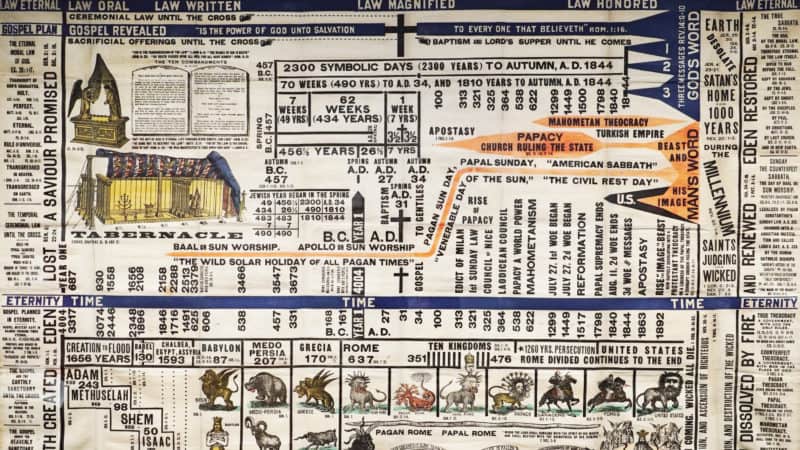
Beginnings of the Advent Movement
As you can imagine, as soon as the clock ticked past midnight on October 22, people were bewildered, angry, even scared. Many gave up their beliefs, and many went back to the churches they attended before.
Others, however, who had studied the passages Miller emphasized knew this was still an important piece of prophecy. They continued their study, wondering where they might have made a mistake. Especially because the Bible itself says the timing of Christ’s return is not known by anyone except God the Father.
“Heaven and earth will pass away, but my words will not pass away. But concerning that day or that hour, no one knows, not even the angels in heaven, nor the Son, but only the Father” (Mark 13:31, 32, ESV).((Also see Matthew 24: 36-44 and 1 Thessalonians 5:1-3))
Over the next 15 years, many former Millerites continued their studies of prophecy and Christ’s Second Coming to see what more they could learn. They established multiple “Bible conferences,” or formal groups and events focused on studying Scripture, and identified a series of Bible truths that were forgotten or neglected since the days of the early Church.((Downloaded on July 7, 2019 from https://www.adventist.org/en/information/history/article/go/-/united-for-mission-one-hundred-and-fifty-years/)) These truths can be summarized as follows:
- Christ’s second coming is imminent, will be seen by all the world, and it will be literal, not metaphorical.
- The seventh day, Saturday, is God’s Sabbath. The Fourth Commandment’s instruction to celebrate and keep it remains literal to this day (along with the rest of the Ten Commandments).
- God does not eternally torment sinners, but rather the dead “sleep” until the second coming and last judgment.
- Christ now ministers in the heavenly sanctuary, thereby mediating to us the benefits of His death on the cross, saving us by His righteousness and not our own deeds (see Hebrews 8).
- In the last days of this earth, Christians will be tempted by apostasy but be called back to divine truth—the “third angel’s message” of Revelation 14—and a relatively small “remnant” of faithful believers will answer this call.
- This remnant would be marked by a recurrence of the prophetic ministry, and many people will display the prophetic gift and proclaim the good news (see Joel 2:28 and Acts 2:17).
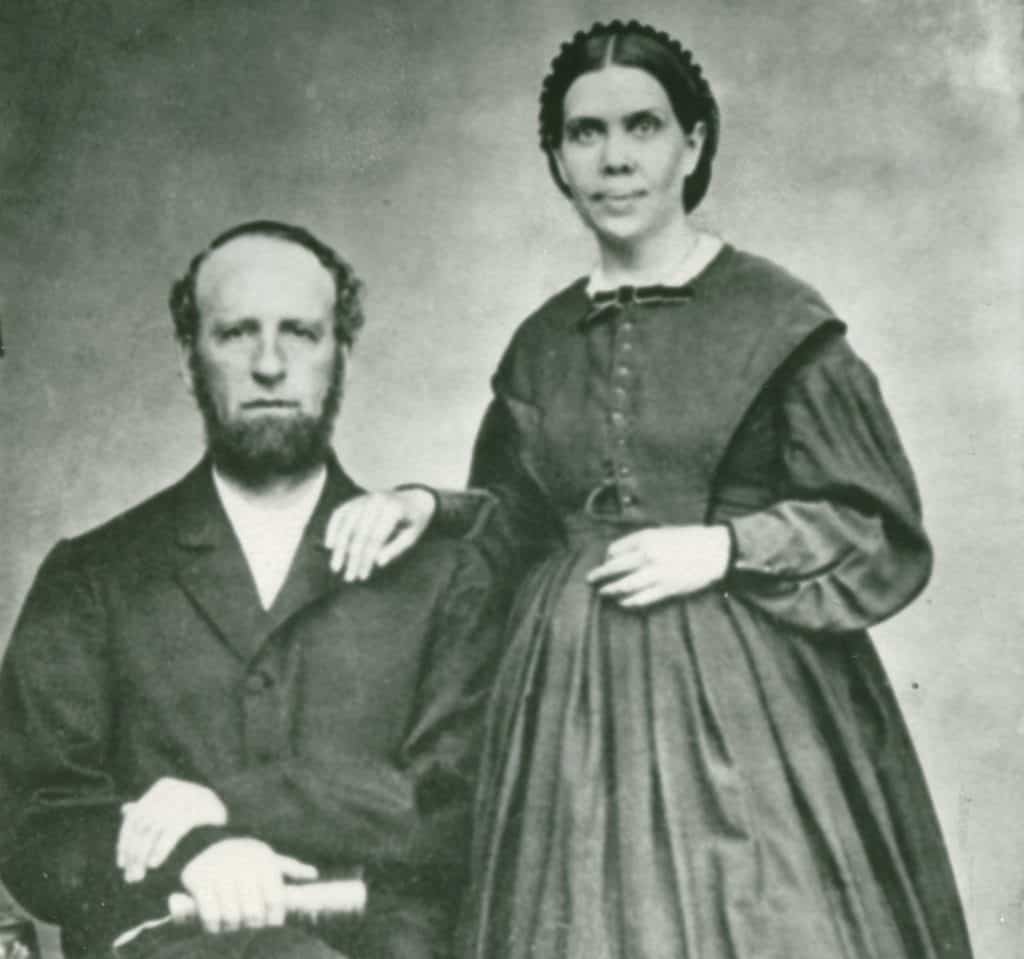
Seventh-day Adventist Church Organizes with the Intent to Spread the Gospel
It’s important to note that while these biblical concepts were still being studied, those leading this movement were guided by a young woman, Ellen G. White. Her profound insight from God on these rediscovered truths astounded Bible scholars and clergy alike. They were also impressed by her humility and insistence for only God to receive glory.
White was recognized as a modern-day recipient of the spiritual gift of prophecy, as described in 1 Corinthians 12, Romans 12, Ephesians 4, and 1 Peter 4:10, 11. She played an integral role in keeping things focused on the Bible, always bringing up new ways to apply these new concepts to daily life.
As time progressed and the aforementioned beliefs were outlined, this movement still only consisted of small groups scattered across the northern United States. They all had these beliefs in common but didn’t make a separate name for themselves.
However, since the established denominations did not acknowledge or practice these truths, it became clear that this movement would become something of its own.
Ellen White’s husband, James, also a prominent figure in early Adventism, began referring to these separate-but-united groups as belonging to “the Great Second Advent Movement.” Others used the term “Sabbatarian Adventist.”((Downloaded on July 7, 2019 from https://www.adventist.org/en/information/history/article/go/-/united-for-mission-one-hundred-and-fifty-years/))
Bible study continued on the central topics in this movement, so these groups kept in touch with the progress through James White’s periodical The Advent Review and Sabbath Herald, which eventually spurred the denomination’s emphasis on publishing as an effective way to spread the gospel. (This periodical still circulates today, now called The Adventist Review.)
Eventually, however, inspired by Christ’s great commission to “go and make disciples” (Matthew 28:19, 20), the Sabbatarian Adventists recognized the need to organize. This would enable them to more effectively share these enlightening biblical truths, showing more people how they can find freedom, healing, and hope in Jesus Christ.
The first vital step toward organization involved a gathering of delegates from across the northern United States on October 1, 1860. These delegates, representing their respective groups and areas of influence, agreed upon the name “Seventh-day Adventists.”
A few years later, in May of 1863, another meeting of delegates from even more congregations of Adventists gathered to form what is now called the General Conference of Seventh-day Adventists. This newly organized denomination united under the purpose to share how a deeper understanding of Scripture not only prepares us for eternity with Christ, but for living more abundant lives in the here and now.((Downloaded on July 7, 2019 from https://www.adventist.org/en/information/history/article/go/-/united-for-mission-one-hundred-and-fifty-years/))
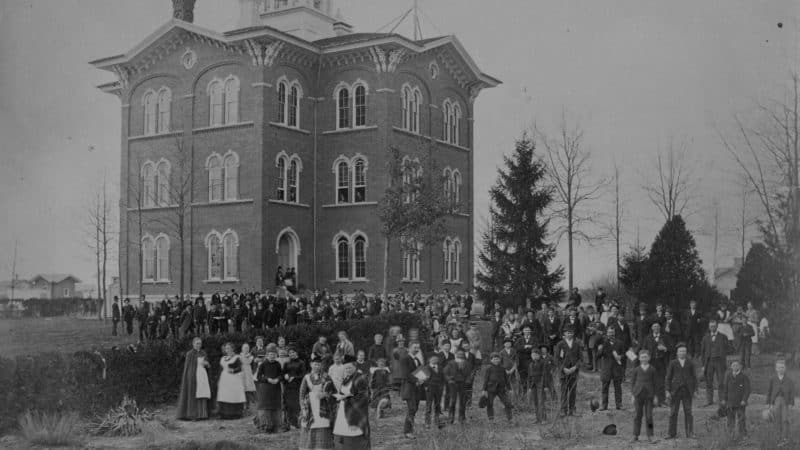
Global Expansion of Adventism
As the Seventh-day Adventist Church continued to spread across the United States, the early church leaders knew this Advent Message of the Three Angels should be shared around the world as well. They would not let themselves become complacent in their “comfort zones,” and they began serious talks about mission work.
James and Ellen White, along with Joseph Bates, an Adventist preacher, urged the development of a plan for missions that included a focus on medical work to help meet the needs of people around the world.
The first Adventist missionary was J.N. Andrews. He was selected to go to England and Switzerland in 1874 to assist Adventist church leaders there. He eventually established the Adventist printing press in Basel, Switzerland.
Ellen White also traveled to Switzerland, as well as South Africa, South America, the South Pacific, and Australia. The Advent Message spread rapidly as missionaries worked closely with publishing houses and gathered teams to canvas different areas and distribute literature. Several of these areas began writing to the General Conference to request more missionaries!
By the end of the 1870s, Adventist membership had tripled, passing 16,000 members. By 1901 there were 75,000 members worldwide, and the Church had also established two colleges, a medical school, 12 secondary schools, 27 hospitals, and 13 publishing houses.
Eventually, the Church also organized regional administrative offices, such as divisions, unions, and conferences, to more efficiently oversee various operations in education, publishing, health and mission work.
Today the Adventist Church continues to grow globally, maintaining its focus on health and wellness, community development and mission work, publishing, and education. The Church currently operates over 8,000 schools around the world, nearly 200 hospitals, and over 50 publishing houses. According to Pew Research, the Seventh-day Adventist denomination is the most ethnically diverse Christian denomination in the world.
With a rich history of dedicated Bible study and a commitment to applying biblical principles to daily life, Adventists remain an active, dedicated global faith community. Together they cling to Jesus as their only hope and eagerly await His Second Coming.
Ready to start Bible studies at your own pace?
Sign up for Bible study lessons TODAY!

Overview of Significant Milestones in Adventist History
Theological Milestones
After 1844’s Great Disappointment, soon-to-be Adventists responded by deepening their Bible study and linked the 2,300-day prophecy in Daniel 8 to cleansing of the Most Holy Place in the heavenly sanctuary, not the earth itself. This led to the formation of the Sanctuary doctrine and the Investigative Judgment (see Hebrews 8).
Following this concept led them to a deeper understanding of the importance of the seventh-day Sabbath. Even beyond Sabbatarian worship in the present day, studying Daniel and Revelation prophecies showed the Sabbath to be significant in earth’s final days, especially in the context of the “Three Angels Messages” (Revelation 14:6-12). The Sabbath is an original commandment to be followed like the other nine, so when the Third Angel proclaims the “patience of the saints” includes keeping the “commandments of God and the faith of Jesus” (NKJV), this includes the original Sabbath day God established for humankind at creation.
These discoveries prompted the early founders’ conviction to preach the gospel around the world, letting people know the significance of these prophecies and what they mean for daily life and spiritual growth.
Additionally, the idea of “present truth” significantly influenced how Adventists approached Scripture. The terminology was taken from 2 Peter 1:12:
“For this reason I will not be negligent to remind you always of these things, though you know and are established in the present truth” (NKJV).
The idea of present truth, as explained by James White, is that in any current time, certain duties or priorities will shift from what they have been, and they will continue to progress again as time goes on. The Word of God, then, should be used to “shine brightly where we stand, and not so plainly on the path in the distance.”
This does not mean that the Bible changes or that God changes, but as more is learned or revealed, the beliefs or positions of the church may need to be adapted to accommodate this spiritual growth while still remaining solid on its biblical roots. Present truth protects against the rigidity of doctrine, recognizing there is always more to learn from an infinite, almighty God.
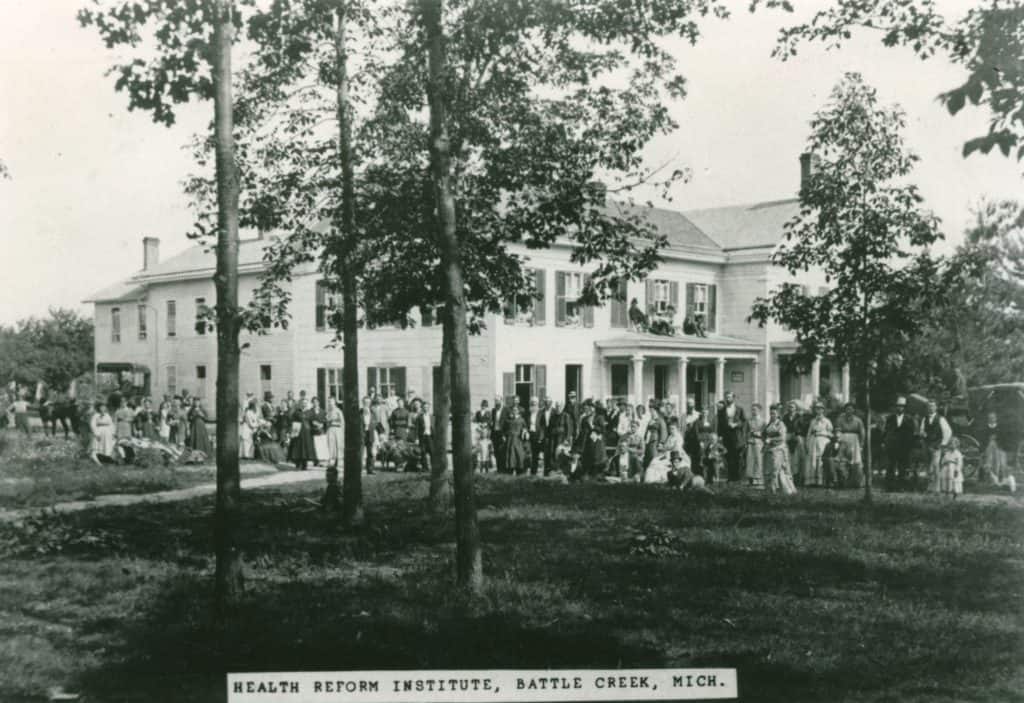
Early Milestones in Ministry and Service
Publishing: In 1848, James and Ellen White were convicted to write, print, and distribute a regular magazine to unite Adventists everywhere. This would allow them to share or discuss important points of theology (this magazine was initially called Present Truth, later changed to the Adventist Review & Sabbath Herald, presently called The Adventist Review)
This conviction to utilize the written word led to the operation of Adventist publishing houses around the world, both for informative and evangelistic purposes.
Health: The 1860s marked the beginning of the Adventist Church’s expansive health reform efforts and healing ministries. Battle Creek Sanitarium in Michigan was established in 1866 as the first Adventist-owned and operated medical institution (also known as the Western Health Reform Institute).
In addition to organized healthcare institutions, early Adventist health reform involved early support of the germ theory of disease((The idea that illnesses and infections are caused by microorganisms, in contrast to the idea that “bad air” or vapor from rotten matter causes disease.)), evidence of the benefits of a vegetarian diet and abstinence from alcohol, tobacco, and recreational drugs.
Education: Adventists believed proper education should include a holistic focus, educating the whole person rather than focusing solely on textbook knowledge. This belief prompted the opening of the first Adventist-sponsored school in Battle Creek, Michigan in 1872. Not long after, Battle Creek College opened in 1874. To provide direction for the future of Adventist education, the General Conference organized their Educational Society that same year.
A Few Famous Seventh-day Adventists
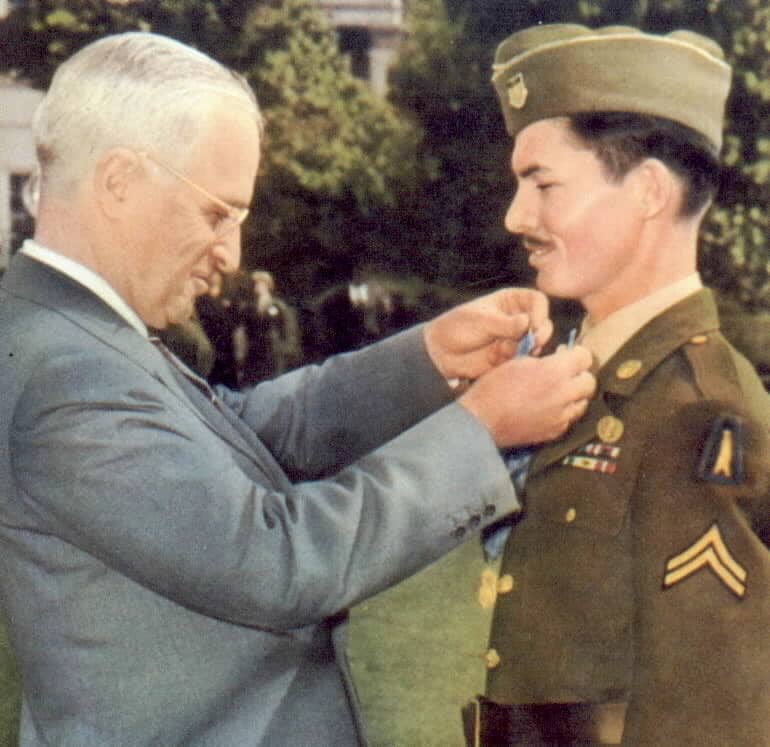
Desmond Doss
Desmond Doss, the “conscientious objector,” enlisted in the US Army in April 1942 but refused to purposely kill others or carry a weapon into combat because of his personal beliefs as a Seventh-day Adventist. He ended up becoming a combat medic during World War II.
His courage and determination in helping wounded soldiers earned him two Bronze Star Medals. During the Battle of Okinawa, he saved the lives of 75 soldiers, which earned him the Medal of Honor. He was the only noncombatant to receive this honor.
Doss was wounded three times during the war, and shortly before leaving the Army, he was diagnosed with tuberculosis, which cost him one lung. After his discharge from the Army in 1946, he spent five years undergoing medical treatment for his injuries and illness.
The life story of Desmond Doss was so incredible that world-renown writer, producer, and director Mel Gibson created a major motion picture about his life and heroic acts: “Hacksaw Ridge.” This movie brought attention to the Adventist denomination’s official position on conscientious objection.
Desmond Doss
Learn more about Desmond Doss’ inspiring story!
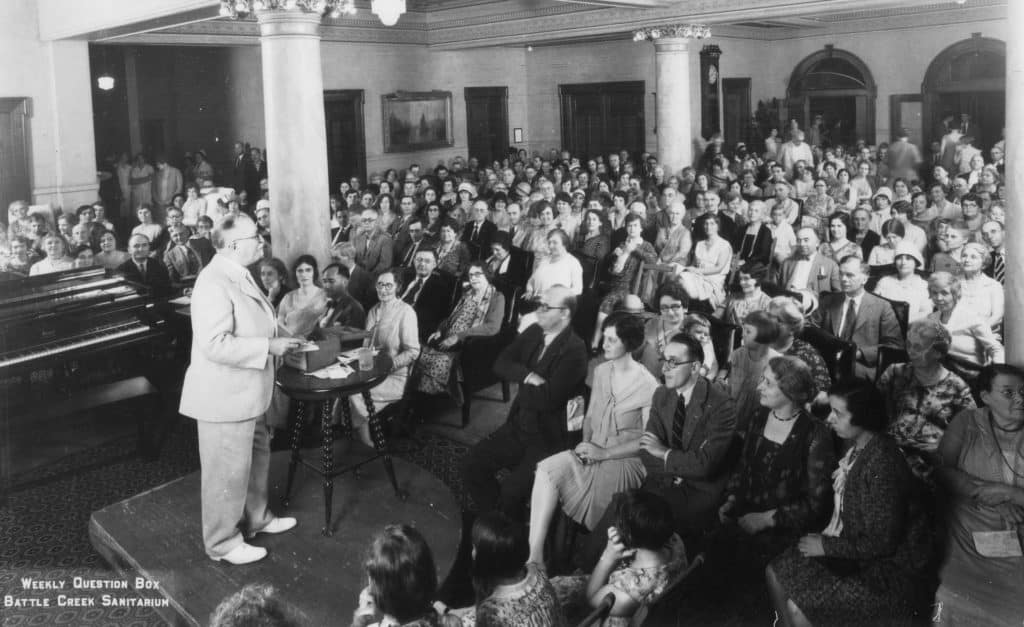
John Harvey Kellogg
John Harvey Kellogg may be a familiar household name because of the breakfast cereals he originally developed in 1896. Kellogg was an inventor, medical doctor, and pioneer in holistic healthcare.
He revolutionized healthcare around the world through his extensive research and promotion of the germ theory of disease(( )), vegetarianism, balanced nutrition, and abstaining from alcohol, tobacco, and drugs. His recommendations for complete wellness included regular exercise, fresh air and sunshine, correct posture, sensible clothing, and an intake of eight to ten glasses of water daily.((Downloaded on July 21, 2019 from https://biography.yourdictionary.com/john-harvey-kellogg))
He became the superintendent of Battle Creek Sanitarium, and under his management it achieved global recognition.
Unfortunately the later years of Kellogg’s story involve his venturing into extremism, both in spirituality and in his business practices, and he was eventually removed from membership of the Adventist Church.

Dr. Ben Carson
Dr. Ben Carson is a renowned neurosurgeon famous for his rise from a difficult early life into noteworthy achievement in college and medical school, and eventually becoming director of pediatric neurosurgery at Johns Hopkins Hospital.
Carson’s fame mostly began in 1987 after his successful surgical separation of twins conjoined at the head. He enjoyed a long medical career specializing in traumatic brain injuries.
His fame only grew with the publishing of his autobiography and the 2009 TV movie with a similar title, Gifted Hands: The Ben Carson Story. This illustrated the difficult childhood experiences Carson dealt with and the obstacles he overcame.
Carson was the featured speaker for the National Prayer Breakfast in 1997 and 2013, and in 2008 he was awarded the Presidential Medal of Freedom. In 2017 he was sworn in as the 17th United States Secretary of Housing and Urban Development.
Carson often gave glory to God for his successes and he remains a faithful member of the Adventist Church today.
The Seventh-day Adventist Church greatly values its heritage and history, praising God for the many ways He has led. They also focus ahead, united in belief and mission, awaiting the return of the world’s Savior, Jesus Christ.
Learn more about what Adventists believe
Ready to start your own spiritual journey?

United for Mission: One Hundred and Fifty Years
From Great Disappointment to General Conference The Millerites firmly believed that Jesus ChristR…
Read More![Publishing Uriah Smith, right, and other Adventist publishing leaders reenact in the 1890s the early days of the church’s publishing ministry. [photos courtesy Office of Archives, Statistics and Research]](https://www.adventist.org/wp-content/uploads/2019/06/csm_printing-early-web-inside_9c39c87447-500x280.jpg)
Publishing work was central to early Adventist Church
In July of 1849, James White packed copies of “The Present Truth” into a borrowed carpetbag and trek…
Read More